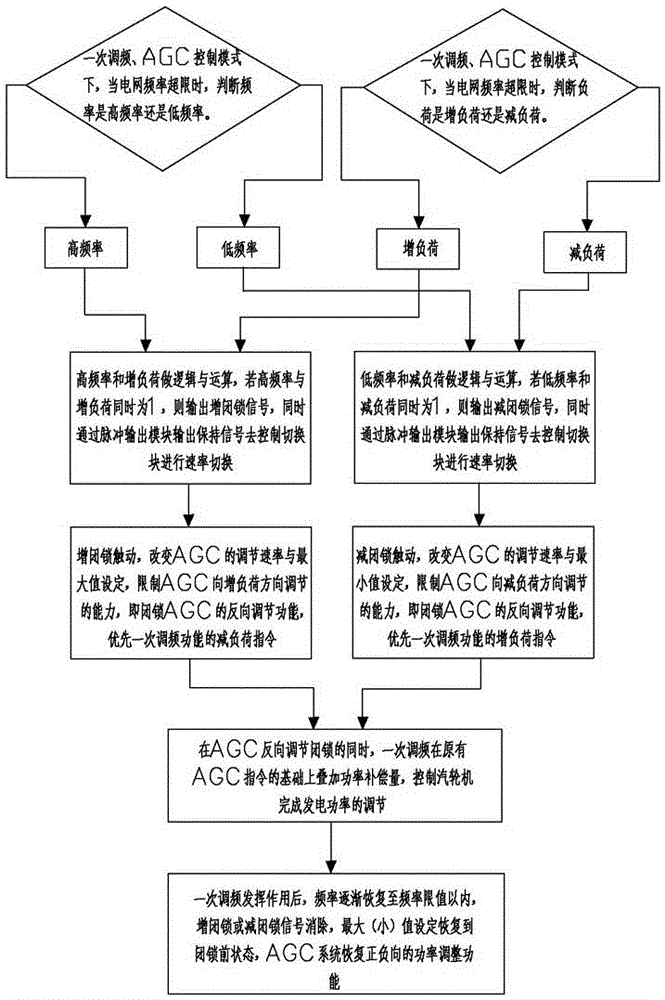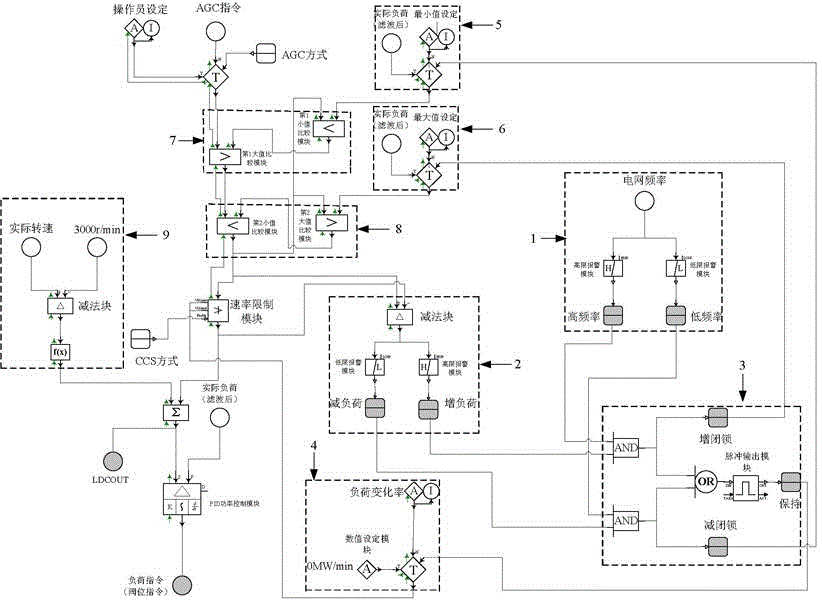Thermal power set primary frequency modulation and AGC coordination control method
A thermal power unit and coordinated control technology, applied in the direction of AC network voltage adjustment, reducing/preventing power oscillation, etc., can solve problems such as deteriorating grid frequency, slow frequency recovery, and unmaintainable primary frequency modulation power compensation, so as to reduce risks and increase The effect of safeguarding the line of defense
- Summary
- Abstract
- Description
- Claims
- Application Information
AI Technical Summary
Problems solved by technology
Method used
Image
Examples
Embodiment 1
[0021] Embodiment 1: as attached figure 1 , 2 As shown, the coordinated control method of primary frequency modulation and AGC of the thermal power unit includes the following steps:
[0022] Step 1: Under the AGC control mode, when the power grid frequency has a large change and exceeds the limit, judge the safety limit of the grid frequency, and judge whether the frequency is high through the high limit alarm module and the low limit alarm module in the frequency judgment unit 1. frequency or low frequency, at the same time, in the load judging unit 2, it is judged whether the AGC system is increasing or reducing the load through the high limit alarm module and the low limit alarm module. Enter the third step for low frequency and load reduction;
[0023] Step 2: After judging the frequency and load, do a logic AND operation on the high frequency and the increased load in the increase / decrease blocking judgment unit 3. If the high frequency and the increased load are 1 at ...
Embodiment 2
[0034] Embodiment 2: as attached figure 1 , 2 As shown, when the unit is in the AGC control mode, the frequency of the grid changes greatly. When the grid frequency is greater than 50.1Hz, the coordinated control method between the primary frequency modulation of the thermal power unit and AGC includes the following steps:
[0035] Step 1: In the frequency judging unit 1, the grid frequency passes through the high-limit alarm module. Since the limit value of the high-limit alarm module is 50.1 Hz, when the frequency is greater than 50.1 Hz, the output is 1. At this time, the grid frequency is greater than 50.1 Hz, so it is High frequency, the output is 1, and at the same time, the signal output by the second small value comparison module is compared with the signal output by the rate limit module in the subtraction block in the load judgment unit 2, and the calculated difference is greater than 1.5, The output of the high limit alarm module is 1, which is to increase the load...
Embodiment 3
[0041] Embodiment 3: as attached figure 1 , 2 As shown, when the unit is in the AGC control mode, the frequency of the power grid changes greatly. When the frequency of the power grid is less than 49.9Hz, the coordinated control method between the primary frequency modulation of the thermal power unit and AGC includes the following steps:
[0042] Step 1: In the frequency judgment unit 1, the grid frequency passes through the low-limit alarm module. Since the limit value of the low-limit alarm module is 49.9Hz, the output is 1 when the frequency is less than 49.9Hz. At this time, the grid frequency is less than 49.9Hz, so it is Low frequency, the output is 1, and the signal output by the second small value comparison module and the signal output by the rate limit module are subtracted in the subtraction block in the load judgment unit 2, and the calculated difference is less than -1.5 , so the output of the low-limit alarm module is 1, which means load reduction, and then ent...
PUM
 Login to View More
Login to View More Abstract
Description
Claims
Application Information
 Login to View More
Login to View More - R&D
- Intellectual Property
- Life Sciences
- Materials
- Tech Scout
- Unparalleled Data Quality
- Higher Quality Content
- 60% Fewer Hallucinations
Browse by: Latest US Patents, China's latest patents, Technical Efficacy Thesaurus, Application Domain, Technology Topic, Popular Technical Reports.
© 2025 PatSnap. All rights reserved.Legal|Privacy policy|Modern Slavery Act Transparency Statement|Sitemap|About US| Contact US: help@patsnap.com


